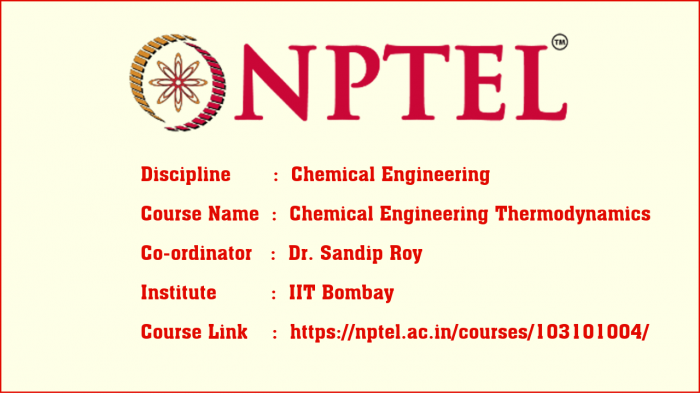Chemical Engineering Thermodynamics - Web Course (DVD)

Media Storage Type : DVD-ROM
NPTEL Course Name : Chemical Engineering Thermodynamics
NPTEL Subject Matter Expert : Dr. Sandip Roy
NPTEL Co-ordinating Institute : IIT Bombay
NPTEL Lecture Count : 77
Lecture Titles:
Chapter 1 - Section 1 : Introduction
Chapter 1 - Section 2 : Thermodynamic System: Select Definitions
Chapter 1 - Section 3 : Types of Energies associated with Thermodynamic Processes
Chapter 1 - Section 4 : Thermodynamic Equilibrium
Chapter 1 - Section 5 : The Phase Rule
Chapter 1 - Section 6 : Zeroth Law of Thermodynamics and Absolute Temperature
Chapter 1 - Section 7 : The Ideal Gas
Chapter 1 - Section 8 : State and Path Dependent Thermodynamic Variables
Chapter 1 - Section 9 : Reversible and Irreversible Thermodynamic Processes
Chapter 1 - Section 10 : Significance of Chemical Engineering Thermodynamics: Process Plant Schema
Chapter 2 - Section 1 : General P-V-T Behaviour of Real Fluids
Chapter 2 - Section 2 : Origins of Deviation from Ideal Gas Behaviour
Chapter 2 - Section 3 : Equations of State for Real Fluids
Chapter 2 - Section 4 : Volumetric Properties of Mixtures
Chapter 2 - Section 5 : Property Representation of 2-phase systems
Chapter 2 - Section 6 : Heat Effects of Phase Change
Chapter 3 - Section 1 : Concept of Internal Energy
Chapter 3 - Section 2 : The First Law of Thermodynamics
Chapter 3 - Section 3 : Application of the First Law to Open Systems
Chapter 3 - Section 4 : Measurement of Enthalpy and Internal Energy using Flow Calorimeter
Chapter 4 - Section 1 : Heat Engins and Second Law Statements
Chapter 4 - Section 2 : Carnot Heat Engine Cycle and the 2nd Law
Chapter 4 - Section 3 : Entropy Calculations for Ideal Gases
Chapter 4 - Section 4 : Mathematical Statement of the 2nd Law
Chapter 4 - Section 5 : Entropy Balance for Open Systems
Chapter 4 - Section 6 : Ideal and Lost Work for Flow Systems
Chapter 4 - Section 7 : Appendix 4.1
Chapter 5 - Section 1 : Thermodynamic Property Relations for Single Phase Systems
Chapter 5 - Section 2 : Maxwell Relations
Chapter 5 - Section 3 : Relations for Enthalpy, Entropy and Internal Energy
Chapter 5 - Section 4 : Residual Property Relations
Chapter 5 - Section 5 : Residual Property Calculation from EOS
Chapter 5 - Section 6 : Generalized Correlations for computing dH and dS for a real gas
Chapter 5 - Section 7 : Computation of delta H and delta S for a Gas using Generalized Departure Functions
Chapter 5 - Section 8 : Extension to Gas Mixtures
Chapter 5 - Section 9 : Relations for delta H and delta S for Liquids
Chapter 5 - Section 10 : Applications to real fluid processes in process plant equipments
Chapter 6 - Section 1 : Partial Molar Property
Chapter 6 - Section 2 : Partial Properties for Binary Solutions
Chapter 6 - Section 3 : Criteria of Thermodynamic Equilibrium
Chapter 6 - Section 4 : The Chemical Potential
Chapter 6 - Section 5 : Ideal Gas Mixtures and Liquid Solutions
Chapter 6 - Section 6 : Excess Properties
Chapter 6 - Section 7 : Fugacity of pure substances
Chapter 6 - Section 8 : Fugacity-based phase equilibrium criterion for pure component system
Chapter 6 - Section 9 : Fugacity expressions for pure gases
Chapter 6 - Section 10 : Generalized Correlations for the Fugacity Coefficient
Chapter 6 - Section 11 : Expression for Fugacity of a Pure Liquid
Chapter 6 - Section 12 : Fugacity and Fugacity Coefficient of Species in Mixture
Chapter 6 - Section 13 : Relation between residual property and species fugacity coefficients in mixtures
Chapter 6 - Section 14 : Expressions for gas phase using EOS
Chapter 6 - Section 15 : The Lewis/Randall Rule
Chapter 6 - Section 16 : Dependence of Excess Gibbs free energy on temperature and pressure
Chapter 6 - Section 17 : The Activity Coefficient
Chapter 6 - Section 18 : Use of VLE data for generation of Activity Coefficient Models
Chapter 6 - Section 19 : Activity Coefficient Models
Chapter 6 - Section 20 : Appendix 6.1
Chapter 6 - Section 21 : Appendix 6.2
Chapter 7 - Section 1 : Introduction of Vapour-Liquid equilibria
Chapter 7 - Section 2 : Single Component System Phase Equilibria
Chapter 7 - Section 3 : Derivation of the Phase Rule
Chapter 7 - Section 4 : Description of General VLE Behavior
Chapter 7 - Section 5 : Raoult Law for VLE
Chapter 7 - Section 6 : VLE Algorithms for Low to Moderate Pressures
Chapter 7 - Section 7 : High Pressure Vapour Liquid Equilibria
Chapter 7 - Section 8 : Henry Law
Chapter 8 - Section 1 : Introduction of Chemical Reaction Equilibria
Chapter 8 - Section 2 : Standard Enthalpy and Gibbs free energy of reaction
Chapter 8 - Section 3 : The Reaction Coordinate
Chapter 8 - Section 4 : Criteria for Chemical Reaction Equilibrium
Chapter 8 - Section 5 : The Equilibrium Constant of Reaction
Chapter 8 - Section 6 : Reactions involving gaseous species
Chapter 8 - Section 7 : Reaction equilibria for simultaneous reactions
Chapter 8 - Section 8 : Reactions involving Liquids and Solids
Chapter 9 - Section 1 : Liquid-liquid Equilibria (LLE)
Chapter 9 - Section 2 : Solid-Liquid Equilibria
Chapter 9 - Section 3 : Solid-Vapour Equilibrium

